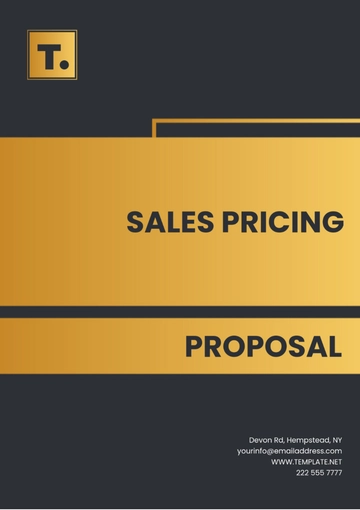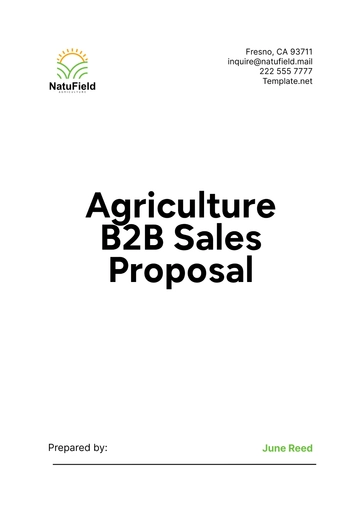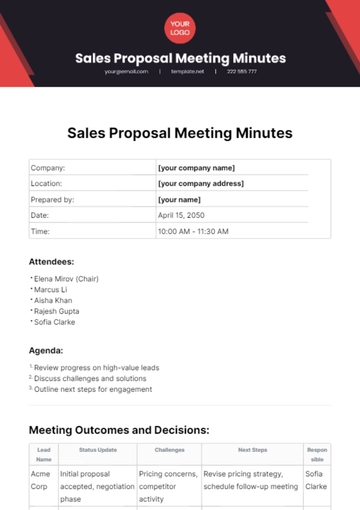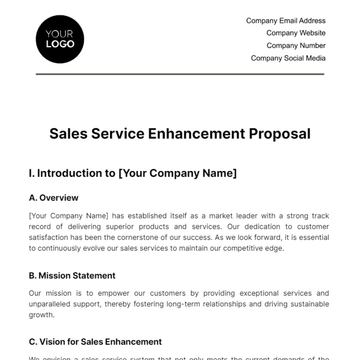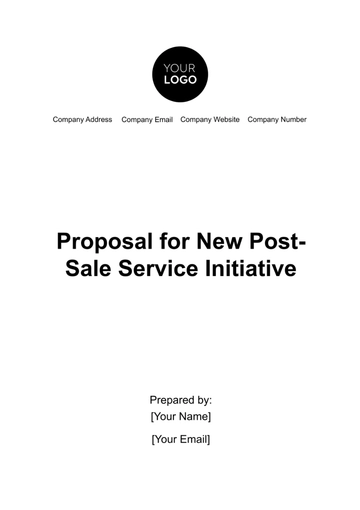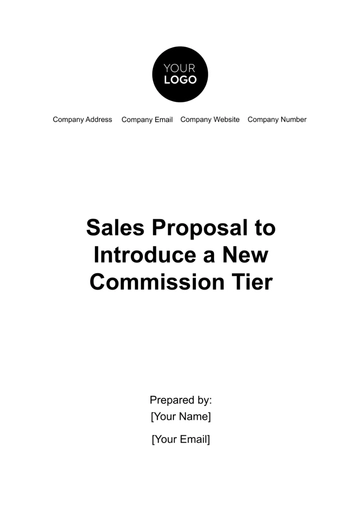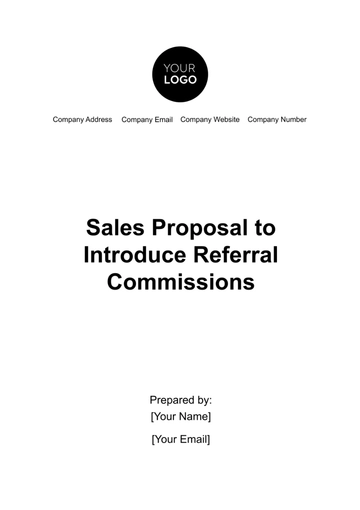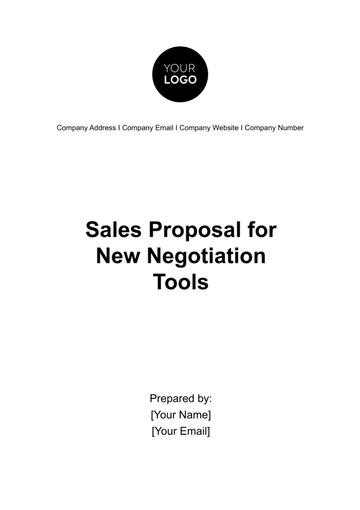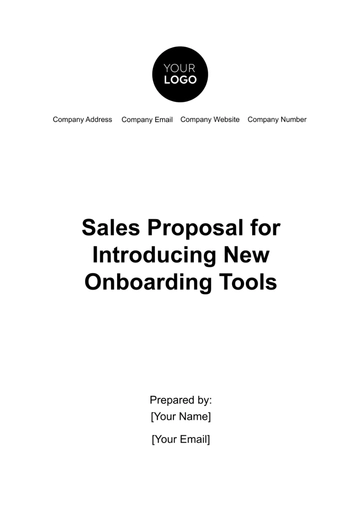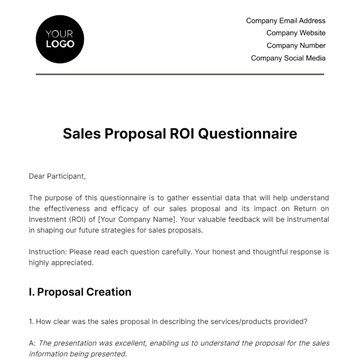Free Sales Prospecting Proposal

Introduction
In today's ever-evolving business landscape, staying competitive requires a proactive approach to identifying and engaging potential clients. Our Sales Prospecting Proposal serves as the cornerstone for a systematic and efficient strategy to drive our sales efforts. This proposal outlines a comprehensive plan for prospecting and lead generation, with the overarching goal of optimizing resource allocation and achieving sustainable revenue growth.
1. Executive Summary
The Executive Summary serves as the compass of our Sales Prospecting Proposal, offering a comprehensive yet concise overview of our prospecting strategy. It provides a clear snapshot of the critical components that shape our approach and sets the tone for the rest of this proposal.
A Comprehensive Strategy:
At its core, this proposal outlines a comprehensive strategy for prospecting and lead generation. This strategy is designed to be systematic, dynamic, and adaptable, with the overarching objective of optimizing resource allocation and achieving sustainable revenue growth.
Navigating the Proposal:
The Executive Summary not only encapsulates our prospecting strategy but also provides a roadmap for navigating the proposal itself. It outlines the key sections, allowing readers to quickly locate and delve into specific areas of interest, including objectives, target audience, prospecting strategies, implementation plan, tracking, and the conclusion.
A Proactive Approach:
Our strategy is proactive, focusing on reaching out to potential clients, nurturing relationships, and generating a consistent flow of high-quality leads. We recognize that in today's competitive market, proactivity is key to staying ahead and fulfilling our growth objectives.
Key Objectives:
The summary highlights our specific objectives, which serve as guiding principles for our prospecting efforts. These objectives encompass identifying and qualifying potential clients, establishing connections, generating high-quality leads, and improving lead management and conversion rates.
Target Audience:
Understanding the target audience is pivotal, and this section emphasizes the significance of defining our ideal customer profile and recognizing the characteristics of those who align with our offerings.
Prospecting Strategies:
Our approach to prospecting encompasses a diverse range of strategies, each tailored to engage potential clients effectively. We emphasize outbound prospecting, inbound marketing, networking and relationship building, and leveraging referrals from satisfied clients and business associates.
Implementation Plan:
The plan is not just theoretical but practical. It outlines the roles and responsibilities of team members, the tools and resources necessary for effective prospecting, the content strategy, and lead nurturing techniques to guide leads through the sales funnel.
Tracking and Reporting:
Our commitment to data-driven decision-making is evident in the section on tracking and reporting. It underlines the importance of collecting and analyzing data, reporting frequency, and the communication channels we will use to share results and insights.
A Call to Action:
The Executive Summary is more than an introduction; it serves as a call to action. It underscores the significance of our prospecting strategy and emphasizes that effective prospecting is not just a strategy but a commitment to excellence and growth.
As we move forward, this summary stands as a reminder that our collective efforts in prospecting and lead generation have the potential to drive our sales efforts to new heights. The possibilities are endless, and our dedication to customer-centricity, data-driven decision-making, and continuous improvement will be the driving force behind our success.
We encourage you to explore the detailed sections within this proposal to gain a deeper understanding of our approach and the steps we will take to achieve our objectives.
2. Objectives
In this section, we detail the specific objectives that drive our prospecting efforts. These objectives serve as our guiding principles and include:
2.1 Identifying and Qualifying Potential Clients: We aim to identify and qualify potential clients within our target market, ensuring that our efforts are focused on those with the highest conversion potential.
2.2 Establishing Connections and Nurturing Relationships: Building genuine connections and nurturing relationships with leads is pivotal to our approach. This objective fosters trust and lays the foundation for successful conversions.
2.3 Generating a Consistent Flow of High-Quality Leads: The consistency of lead generation is crucial. We seek to establish a steady stream of high-quality leads that align with our ideal customer profile.
2.4 Improving Lead Management and Conversion Rates: To enhance our sales efficiency, we aim to streamline lead management and improve conversion rates across the sales funnel.
3. Target Audience
In this section, we identify our ideal customer profile (ICP) and the specific characteristics of companies or individuals that align with our offerings. Understanding our target audience is the cornerstone of effective prospecting.
Key elements include:
3.1 Demographics: We define the demographic factors that make a potential client an ideal fit for our products or services, such as age, gender, location, and industry.
3.2 Behavioral Traits: Understanding the behavioral traits that define our ICP helps us tailor our approach to match their preferences and needs.
3.3 Challenges and Pain Points: By recognizing the challenges and pain points faced by our target audience, we can align our messaging and solutions to address their specific needs.
4. Prospecting Strategies
This section offers an in-depth analysis of our prospecting strategies, with a focus on their practical implementation. The key strategies include:
4.1 Outbound Prospecting: Outlining a structured plan for outbound prospecting activities, which may include cold calls, personalized emails, and social media outreach. This approach emphasizes the proactive engagement of potential clients.
4.2 Inbound Marketing: Strategies for attracting leads through inbound marketing efforts, including content marketing, search engine optimization (SEO), webinars, and thought leadership. Inbound marketing positions us as experts and draws potential clients to our brand.
4.3 Networking and Relationship Building: Our approach includes attending industry events, conferences, and forming strategic alliances with partners. Networking and relationship building create valuable connections and opportunities for lead generation.
4.4 Referrals: Leveraging our existing clients and business associates to generate referrals. This strategy capitalizes on the trust established with current clients and fosters word-of-mouth recommendations.
5. Implementation Plan
This section provides a step-by-step implementation plan for our prospecting strategies, covering crucial elements such as:
5.1 Roles and Responsibilities: Identifying team members responsible for prospecting activities and defining their roles and responsibilities. This ensures that everyone understands their contribution to the prospecting process.
5.2 Prospecting Tools and Resources: Detailing the tools, software, and resources required for effective prospecting. This includes CRM systems, lead databases, and communication tools.
5.3 Content Strategy: Outlining a content creation and distribution plan. Content is a powerful lead magnet, and our strategy involves producing informative and engaging content tailored to our target audience.
5.4 Lead Nurturing: Defining how leads will be nurtured throughout the sales funnel. The lead nurturing process is crucial for maintaining engagement and guiding leads towards conversion.
6. Tracking and Reporting
This section explains the metrics and key performance indicators (KPIs) that will be used to measure the effectiveness of our prospecting efforts. We will utilize a combination of quantitative and qualitative indicators to gauge progress. The tracking and reporting process includes:
6.1 Data Collection: The collection of data from various prospecting channels and activities, including lead generation, outreach, and conversion rates.
6.2 Analysis: The analysis of collected data to assess the performance of our strategies. We will regularly examine KPIs and metrics to identify trends and areas that require adjustment.
6.3 Reporting Frequency: Defining the frequency of reporting, which may be weekly, monthly, or quarterly, depending on the nature of prospecting activities.
6.4 Communication Channels: Outlining the communication channels and platforms that will be used to share results and insights with the team and stakeholders.
7. Conclusion
The conclusion of our Sales Prospecting Proposal is not just the final segment of this document; it marks the beginning of a transformative journey for our sales and marketing efforts. This section underscores the overarching significance of our prospecting strategy and the potential impact it can have on our business.
A Call to Action:
This proposal is more than just a plan; it is a call to action. It encapsulates the essence of our commitment to data-driven decision-making, customer-centricity, and continuous improvement. It signals the start of a focused and systematic approach to lead generation.
The Significance of Effective Prospecting:
Effective prospecting is the lifeblood of our sales process. It is the vital link that connects us with potential clients who can benefit from our products or services. The success of our business is intrinsically tied to the quality and consistency of our prospecting efforts.
Every Connection Matters:
In our journey of prospecting and lead generation, we must remember that every connection we make matters. Each interaction, every relationship we nurture, and every lead we generate brings us closer to our revenue and growth objectives.
Data-Driven Decision-Making:
This proposal emphasizes the importance of data-driven decision-making. By regularly tracking and analyzing the performance of our prospecting strategies, we can fine-tune our approach, allocate resources more effectively, and make informed choices that lead to improved outcomes.
Customer-Centricity:
A fundamental principle underlying our prospecting strategy is customer-centricity. By understanding the needs and preferences of our target audience, we can create personalized experiences that resonate with potential clients. This approach is not just about selling; it's about solving problems and fulfilling needs.
Continuous Improvement:
Our commitment to continuous improvement is the driving force behind this proposal. We recognize that the business landscape is dynamic, and what works today may require adjustment tomorrow. By embracing a culture of constant evolution, we can adapt to changes and emerging trends, staying agile and responsive.
The Potential Impact:
The potential impact of effective prospecting is significant. It includes:
Sustainable Growth: A steady flow of high-quality leads lays the foundation for sustainable revenue growth.
Enhanced Efficiency: Streamlining lead generation and conversion processes can lead to greater efficiency and cost-effectiveness.
Stronger Client Relationships: Building trust and nurturing relationships with leads can result in loyal, long-term clients who become advocates for our brand.
Competitive Advantage: A proactive approach to prospecting positions us as leaders in our industry, providing a competitive edge.
Business Expansion: Successful prospecting can open doors to new markets and opportunities, expanding our reach and impact.
In conclusion, our Sales Prospecting Proposal is not just a document; it is a commitment to excellence. It is a testament to our dedication to delivering value to our clients and achieving our business goals. The success of this proposal will depend on the collective efforts of our team and our unwavering commitment to the principles it outlines.
As we embark on this journey of prospecting and lead generation, let us remember that each lead is a potential success story. Each interaction is an opportunity to make a difference. The potential is immense, and the possibilities are endless. Together, we will drive our sales efforts to new heights and chart a course for growth and prosperity.
For more in-depth insights and to discuss the specific implementation of this prospecting strategy, please feel free to reach out. Your feedback and insights are invaluable as we work collectively toward our shared goals.
- 100% Customizable, free editor
- Access 1 Million+ Templates, photo’s & graphics
- Download or share as a template
- Click and replace photos, graphics, text, backgrounds
- Resize, crop, AI write & more
- Access advanced editor
Craft winning sales prospecting strategies with Template.net's Sales Prospecting Proposal Template. This versatile tool outlines objectives, target audience, and diverse prospecting strategies. Embrace a proactive approach to connect with potential clients, nurture relationships, and generate high-quality leads. Make informed decisions and drive sustainable revenue growth with this dynamic proposal template that you can easily edit and customize before downloading using our AI editor tool.
You may also like
- Business Proposal
- Research Proposal
- Proposal Request
- Project Proposal
- Grant Proposal
- Photography Proposal
- Job Proposal
- Budget Proposal
- Marketing Proposal
- Branding Proposal
- Advertising Proposal
- Sales Proposal
- Startup Proposal
- Event Proposal
- Creative Proposal
- Restaurant Proposal
- Blank Proposal
- One Page Proposal
- Proposal Report
- IT Proposal
- Non Profit Proposal
- Training Proposal
- Construction Proposal
- School Proposal
- Cleaning Proposal
- Contract Proposal
- HR Proposal
- Travel Agency Proposal
- Small Business Proposal
- Investment Proposal
- Bid Proposal
- Retail Business Proposal
- Sponsorship Proposal
- Academic Proposal
- Partnership Proposal
- Work Proposal
- Agency Proposal
- University Proposal
- Accounting Proposal
- Real Estate Proposal
- Hotel Proposal
- Product Proposal
- Advertising Agency Proposal
- Development Proposal
- Loan Proposal
- Website Proposal
- Nursing Home Proposal
- Financial Proposal
- Salon Proposal
- Freelancer Proposal
- Funding Proposal
- Work from Home Proposal
- Company Proposal
- Consulting Proposal
- Educational Proposal
- Construction Bid Proposal
- Interior Design Proposal
- New Product Proposal
- Sports Proposal
- Corporate Proposal
- Food Proposal
- Property Proposal
- Maintenance Proposal
- Purchase Proposal
- Rental Proposal
- Recruitment Proposal
- Social Media Proposal
- Travel Proposal
- Trip Proposal
- Software Proposal
- Conference Proposal
- Graphic Design Proposal
- Law Firm Proposal
- Medical Proposal
- Music Proposal
- Pricing Proposal
- SEO Proposal
- Strategy Proposal
- Technical Proposal
- Coaching Proposal
- Ecommerce Proposal
- Fundraising Proposal
- Landscaping Proposal
- Charity Proposal
- Contractor Proposal
- Exhibition Proposal
- Art Proposal
- Mobile Proposal
- Equipment Proposal
- Student Proposal
- Engineering Proposal
- Business Proposal




